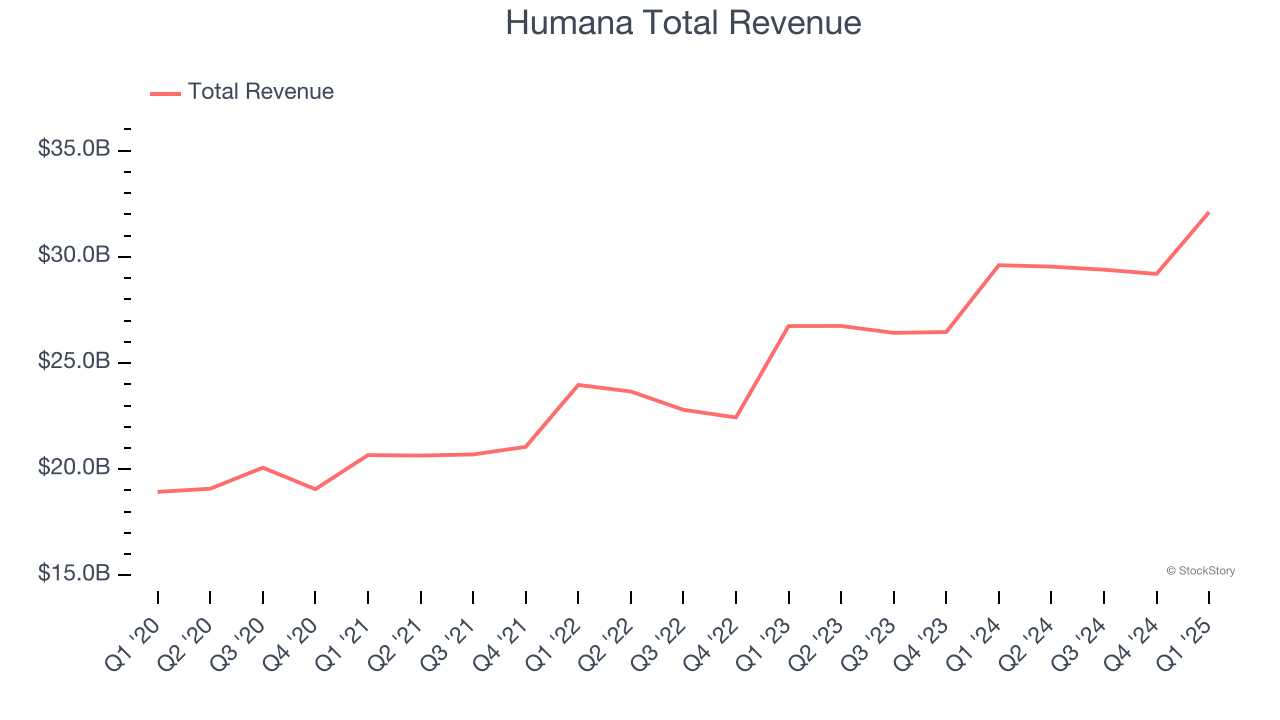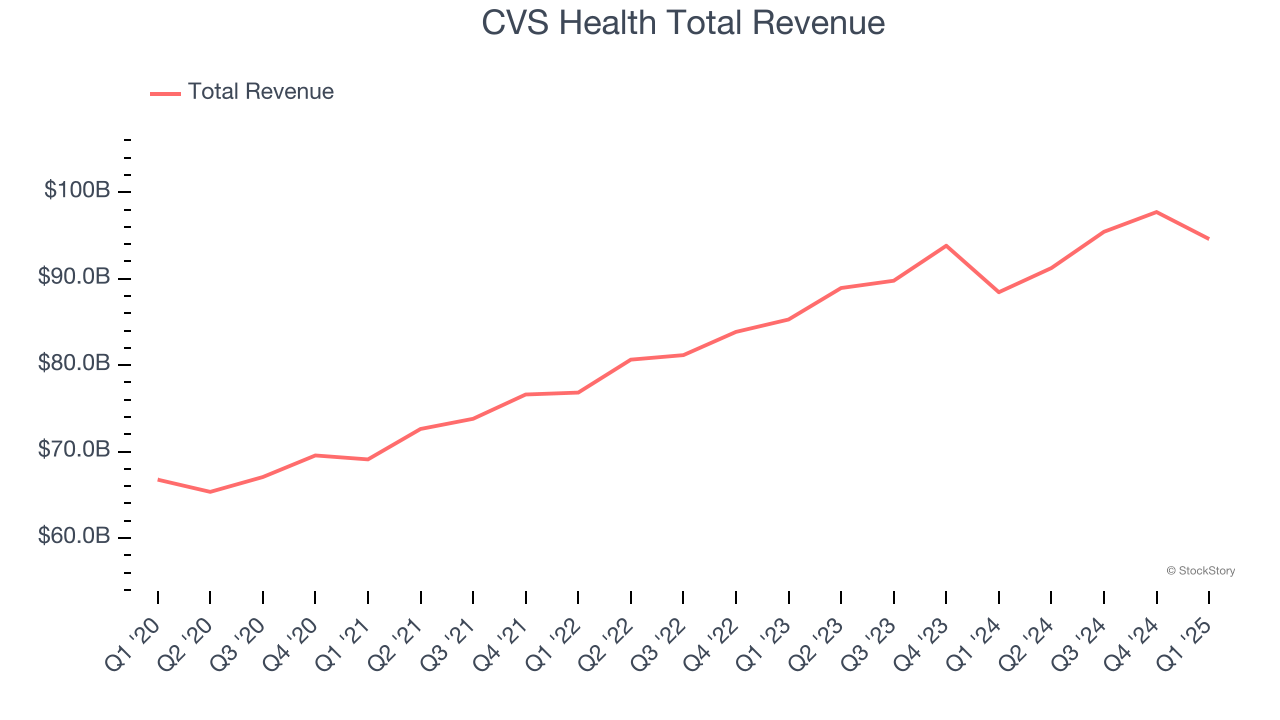
Quarterly earnings results are a good time to check in on a company’s progress, especially compared to its peers in the same sector. Today we are looking at Humana (NYSE: HUM) and the best and worst performers in the health insurance providers industry.
Upfront premiums collected by health insurers lead to reliable revenue, but profitability ultimately depends on accurate risk assessments and the ability to control medical costs. Health insurers are also highly sensitive to regulatory changes and economic conditions such as unemployment. Going forward, the industry faces tailwinds from an aging population, increasing demand for personalized healthcare services, and advancements in data analytics to improve cost management. However, continued regulatory scrutiny on pricing practices, the potential for government-led reforms such as expanded public healthcare options, and inflation in medical costs could add volatility to margins. One big debate among investors is the long-term impact of AI and whether it will help underwriting, fraud detection, and claims processing or whether it may wade into ethical grey areas like reinforcing biases and widening disparities in medical care.
The 11 health insurance providers stocks we track reported a strong Q1. As a group, revenues beat analysts’ consensus estimates by 3% while next quarter’s revenue guidance was in line.
Amidst this news, share prices of the companies have had a rough stretch. On average, they are down 10.8% since the latest earnings results.
Humana (NYSE: HUM)
With over 80% of its revenue derived from federal government contracts, Humana (NYSE: HUM) provides health insurance plans and healthcare services to approximately 17 million members, with a strong focus on Medicare Advantage plans for seniors.
Humana reported revenues of $32.11 billion, up 8.4% year on year. This print was in line with analysts’ expectations, but overall, it was a mixed quarter for the company with an impressive beat of analysts’ EPS estimates but a significant miss of analysts’ customer base estimates.

The stock is down 11% since reporting and currently trades at $230.90.
Is now the time to buy Humana? Access our full analysis of the earnings results here, it’s free.
Best Q1: CVS Health (NYSE: CVS)
With over 9,000 retail pharmacy locations serving as neighborhood health destinations across America, CVS Health (NYSE: CVS) operates retail pharmacies, provides pharmacy benefit management services, and offers health insurance through its Aetna subsidiary.
CVS Health reported revenues of $94.59 billion, up 7% year on year, outperforming analysts’ expectations by 1.5%. The business had an exceptional quarter with a solid beat of analysts’ same-store sales estimates and an impressive beat of analysts’ EPS estimates.

Although it had a fine quarter compared its peers, the market seems unhappy with the results as the stock is down 5.6% since reporting. It currently trades at $62.98.
Is now the time to buy CVS Health? Access our full analysis of the earnings results here, it’s free.
Weakest Q1: UnitedHealth (NYSE: UNH)
With over 100 million people served across its various businesses and a workforce of more than 400,000, UnitedHealth Group (NYSE: UNH) operates a health insurance business and Optum, a healthcare services division that provides everything from pharmacy benefits to primary care.
UnitedHealth reported revenues of $109.6 billion, up 9.8% year on year, falling short of analysts’ expectations by 1.7%. It was a softer quarter as it posted a significant miss of analysts’ full-year EPS guidance estimates and a slight miss of analysts’ EPS estimates.
UnitedHealth delivered the weakest performance against analyst estimates in the group. The company added 395,000 customers to reach a total of 54.12 million. As expected, the stock is down 48.9% since the results and currently trades at $298.95.
Read our full analysis of UnitedHealth’s results here.
Elevance Health (NYSE: ELV)
Formerly known as Anthem until its 2022 rebranding, Elevance Health (NYSE: ELV) is one of America's largest health insurers, serving approximately 47 million medical members through its network-based managed care plans.
Elevance Health reported revenues of $48.89 billion, up 14.8% year on year. This print beat analysts’ expectations by 5.3%. It was a strong quarter as it also recorded a narrow beat of analysts’ full-year EPS guidance estimates and a decent beat of analysts’ EPS estimates.
The company added 99,000 customers to reach a total of 45.83 million. The stock is down 7.1% since reporting and currently trades at $377.95.
Read our full, actionable report on Elevance Health here, it’s free.
Centene (NYSE: CNC)
Serving nearly 1 in 15 Americans through its government healthcare programs, Centene (NYSE: CNC) is a healthcare company that manages government-sponsored health insurance programs like Medicaid and Medicare for low-income and complex-needs populations.
Centene reported revenues of $46.62 billion, up 15.4% year on year. This result surpassed analysts’ expectations by 8.3%. Overall, it was a strong quarter as it also logged full-year revenue guidance exceeding analysts’ expectations and an impressive beat of analysts’ EPS estimates.
Centene achieved the highest full-year guidance raise among its peers. The company lost 656,600 customers and ended up with a total of 27.94 million. The stock is down 8.4% since reporting and currently trades at $56.38.
Read our full, actionable report on Centene here, it’s free.
Market Update
Thanks to the Fed’s series of rate hikes in 2022 and 2023, inflation has cooled significantly from its post-pandemic highs, drawing closer to the 2% goal. This disinflation has occurred without severely impacting economic growth, suggesting the success of a soft landing. The stock market thrived in 2024, spurred by recent rate cuts (0.5% in September and 0.25% in November), and a notable surge followed Donald Trump’s presidential election win in November, propelling indices to historic highs. Nonetheless, the outlook for 2025 remains clouded by potential trade policy changes and corporate tax discussions, which could impact business confidence and growth. The path forward holds both optimism and caution as new policies take shape.
Want to invest in winners with rock-solid fundamentals? Check out our Top 6 Stocks and add them to your watchlist. These companies are poised for growth regardless of the political or macroeconomic climate.
Join Paid Stock Investor Research
Help us make StockStory more helpful to investors like yourself. Join our paid user research session and receive a $50 Amazon gift card for your opinions. Sign up here.







